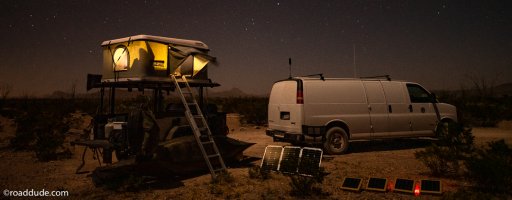A lot of dual charging systems with isolators and switches or DC-DC charging setups are expensive, overthought, and over-built for what most folks need for occasional adventures.
After spending as much time on the road camping and wandering off-grid as I do, living out of a vehicle on adventures lasting several months, I'm convinced
a lot of gear folks buy (not just power systems) is because they think they have to have it to get by. And that it looks cool and everyone else is getting it, so you think you should too. I've done it myself more than I care to admit. I've sold or given most of it away. I still have a murder spork, brand new, I'm selling.
Battery systems for vehicle camping really do not need to be as complicated or as expensive as most setups seem to be trending towards.
You can also, and easily, put together a very efficient and long-lasting house battery set-up, with solar as primary input, that is independent of the starting battery.
I've been running two Odyssey 50ah AGM in my trailer for almost three years, completely independent of my starting batteries. I have a Duramax diesel, so two starting batts. Other than the trickle charge the trailer batteries get through the 7way trailer plug when driving, they are completely powered by solar. No isolator from the starting batteries, no DC-DC charger. I rarely ever run anything from the starting batteries unless driving down the road and charge my phone or use an iPod.
I do have a
NOCO Genius Mini 2 smart charger ($99) hooked to the trailer batts if I ever want to plug into shore power. Not the NOCO jump starter deals, but a smart charger that stays in place 24/7. It's on the near wall in the image below, wired in full-time. I rarely use it, though like having it as back up.
My trailer batteries power my 12v ARB Fridge/Freezer, all the LED rock, work, and cargo lights on my trailer (second image below) the water pump, several USB ports for mobile devices, an air compressor, and through an inverter (now in the compartment next to the NOCO) charge my electric bike, camera batteries (I'm a photog so use a lot of rechargeables), all my flashlight and other rechargeable AA and AAA batts, and sometimes cordless power tool batteries. I also run my laptop regularly (even run a cord from trailer into the van to power it there) and occasionally an electric hair trimmer and other small tools.
While I'm not running all of that during The Big Pause, my trailer and batteries have not been hooked to shore power
or the van for months and are still full every time I check them, just from the portable 120w folding panel I have strapped to the roof of the RTT. It's on the ground in the third image below.
I keep it strapped to the RTT roof when underway or parked for long anywhere. It pretty much lives up there, actually, unless I'm in camp, in which case I move it around during the day for maximum gain.
I agree with
@leeloo, too, and am not a fan of the all-in-one type "power stations." They're mostly, from what I've seen, a dressed up battery with built-in inverter and usb outlets, marketed mainly to folks new to off-grid power as convenient and easy. I don't like them.

..

..

..
Power systems really do not need to be overly complex.
.
Roaddude - Traveling Photographer/Writer/Artist On the Road In North America. Gear, reviews, people, places, and culture.

roaddude.com



















